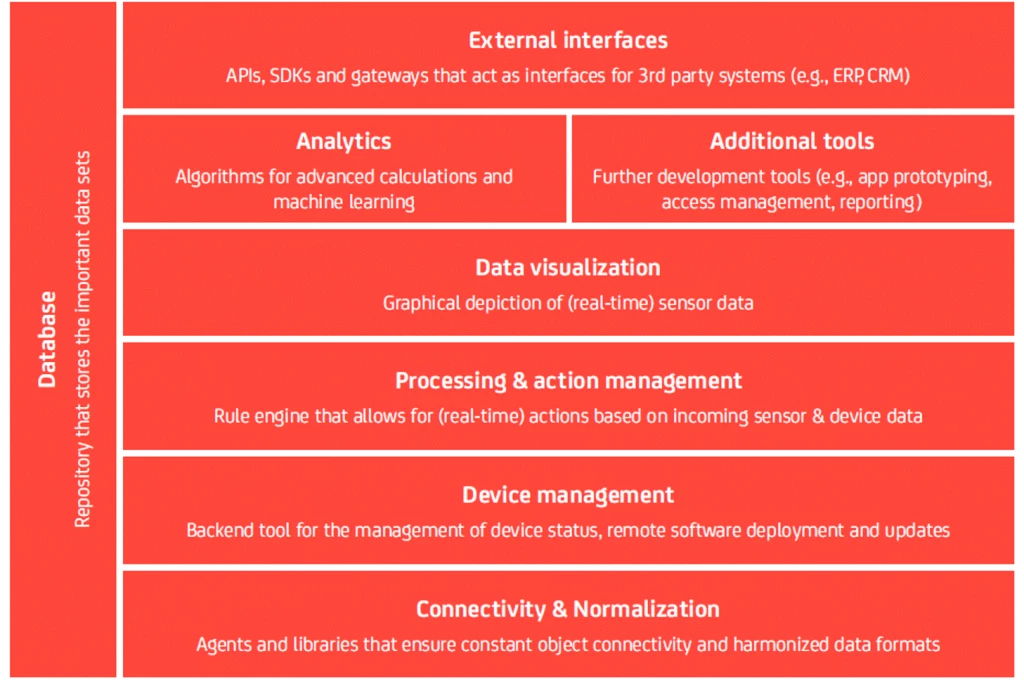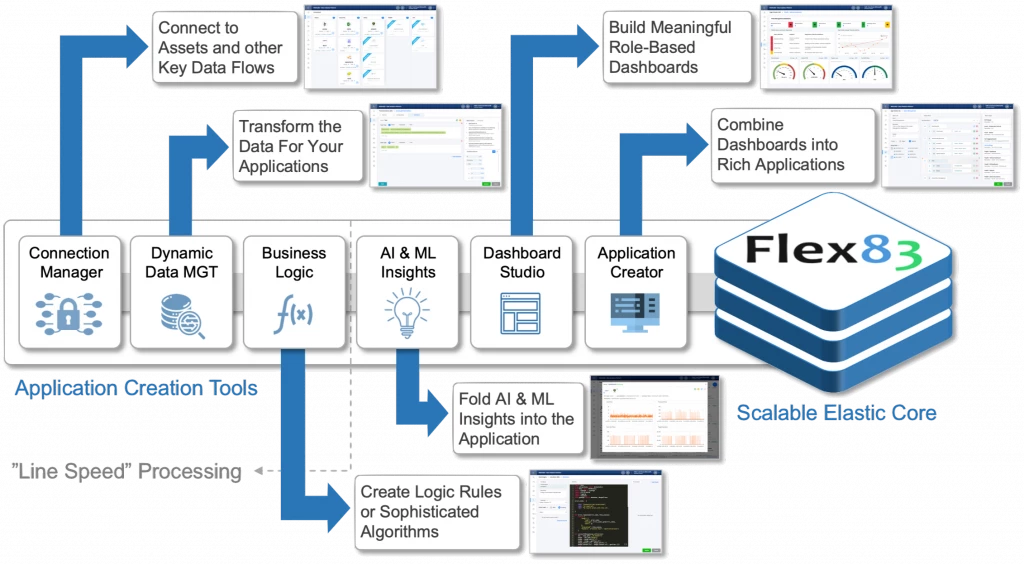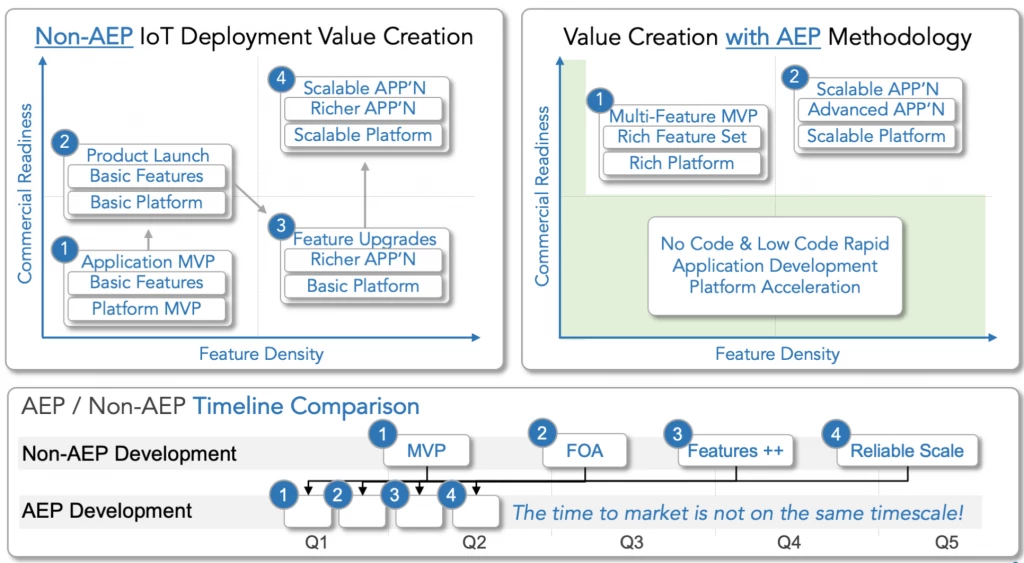
IoT Needs a Low-Complexity Path to Full Application Creation
IoT Applications are built from multiple diverse technology components – from sensors, data aggregators, and edge intelligence devices, to data delivery services, to application ingestion & data transformation, to data storage & Management, to analytics and business logic code engines, to dashboard creation tools, finally, to application layers – and all of this must run in a highly secure, scalable and always-on solution. Moreover, IoT Applications are inherently diverse – connecting disparate devices, serving different business needs, and often integrating to specialized back-end software. Adding to this complexity, IoT Applications must be able to efficiently and cost-effectively evolve as application use case change, new devices or data flows are added, or customer requirements grow.
As a result of the inherent IoT complexity, it is easy for even experienced teams to see the costs and schedules for IoT programs to get out of control, leading to disappointing results, or even abandoned projects. This is also the reason for the slower than anticipated delivery of the economic benefits of IoT. While low-cost sensors and edge processing, ubiquitous communications (WiFi, LTE, LTE-M, LoRa, etc.), low-cost cloud computing, and powerful open-source software are all available, the complexity of putting together unique/bespoke applications remained a barrier to success. Simply put, the overhead and complexity of composing these entire stacks and then building custom applications on top – even when using the very nice tools from the IoTaaS providers – has been too hard.
IoT Application Enablement Platforms (AEP) squarely address the issue, opening the door for enterprises, operators, and OEM to realize the benefits of IoT. A best-in-class AEP will not only provide a secure, reliable, and scalable underlying IoT platform with all of the essential technology and service components but will also provide a complete set of tools and workflows to enable the efficient creation of unique/bespoke applications. Using an AEP, the creation of sophisticated new applications now takes days or weeks – instead of months or even years. By adopting an AEP, enterprises, operators, and OEMs can much more directly apply their skills and industry know-how to in-demand customer solutions – instead of underlying complexity.
And beyond the underlying secure, reliable, and scalable platform and application creation tools, a good AEP might provide a location-tracking feature instead of a more restrictive fleet tracking feature. Or, it can provide alarm & alerts prioritization and management modules and anomaly detection and diagnostic modules & building blocks. The Low Code workflows help to accelerate the creation of applications. Specific predictive maintenance solutions enable an AEP to increase the scope and value of the Lego Blocks you need to realize your complete and powerful application – all accelerating your IoT value creation. So, and AEP will dramatically accelerate the creation of your first iteration application, but will also make it easy to iteratively add layers of sophistication, connectivity to other systems, add new customer features, and much more.
IoT Application Enable Platform (AEP) – The Architectural Building Blocks
According to MachNation, an IoT AEP is a technology-centric offering, enhanced to provide an industry-agnostic and extensible middleware core for constructing a series of interconnected or independent IoT solutions for businesses. This allows industrial enterprises to implement predictive maintenance, machine learning, factory automation, asset logistics, surveillance, and many other applications at a far lower cost, risk, and time to market. An AEP aids businesses in constructing end-to-end solutions with intelligence embedded in smart devices working in conjunction with cloud-based applications for monitoring, analysis, or automation. With IoT83’s Flex83, AEP users can build applications more efficiently, in less time and create solutions that securely scale to millions of devices to fulfill digital transformation goals and expand the scope of portfolio offerings. AEPs like Flex83 offer flexibility in connecting different types of devices, as well as the implementation of domain-specific data models, analytical services, and diverse multi-application / multi-device / multi-role solutions. Below is a reference AEP architecture:

According to IoT Analytics, an AEP consists of eight key aspects:
- Connectivity and Normalisation– Simplifies connectivity of different devices, protocols and a variety of data formats into one software interface to ensuring continuous connectivity, accurate data streaming, interaction between various devices and harmonised data formats. Simplified data transformation and normalization is an important AEP function.
- Device Management– Delivers lifecycle management functionality for connected devices, including device onboarding, deployment of software and firmware updates, and configuration of managed devices.
- Database– Cloud-Based repository scalable in terms of data volume, velocity, variety and veracity. Top AEPs will provide multiple databases to optimize based on data types, and also to simplify cross-application communications, in effect providing data-lake functions.
- Processing and Action Management– Provides a rule engine that to enable of rule-based event-action triggers, to launches diverse actions based on the real-time data streams processing. Also provide the infrastructure to host more complex event handlers.
- Analytics– Uses algorithms for a variety of calculations, from basic data clustering to predictive analytics obtaining the most value from data-stream. The best AEPs will provide both no-code (automatic) as well as custom algorithm & data analytics hosting & operation.
- Visualisation– Enables graphical display of real-time and historical data, enabling patterns and trends observed in visualisation dashboards and reports. The best AEPs will provide built-in dashboards, dashboard creation, and new application creation workflows.
- Additional tools– Allows developers to prototype, test and market their IoT use cases by creating apps that enable them to visualize, manage and control connected devices.
- External interfaces– Include APIs, libraries, SDKs and gateways facilitate integration with third-party systems and to enable leverage of the rest of the IoT ecosystem.
Key Advantages of an IoT Application Enablement Platform (AEP):
Expanding on the definition for AEPs, exploring the advantages of an AEP becomes more clear:
Device Integration: With an AEP like Flex83 divers devices, data-flows, machines, and applications can be integrated with one another in a hassle-free manner. Fresh devices can also be added, configured, and deployed to the environment, or new firmware, revisions, or software patches can be scheduled and deployed to currently running devices without any problem.
Remote Management for Edge Devices: IoT AEPs provide operations teams with mechanisms for edge device onboarding, configuration, health monitoring, life-cycle management, and sunsetting. An AEP will provide workflows for provisioning, maintaining, and deprovisioning IoT devices. With Flex83, all of these tools are available on a per-device basis or as a batch process. Remote management for edge devices reduces on-premise modifications by technicians. Flex83 Rapid Application Development provides all of these capabilities using over-the-air (OTA) mechanisms so operations teams can respond promptly and efficiently while maintaining high levels of safety and security.
Operational Sophistication for Always-On Reliability: IoT application enablement platforms deliver management and monitoring capabilities for the platform and for connected devices. AEPs have configuration, system update mechanisms, and audit and logging capabilities that improve functionality, reduce implementation and integration complexity, and expedite routine management. Operational sophistication is created when AEP vendors like Flex83 focus on providing platform management, device monitoring and management, a unified and refined product solution, and consistent and clean user interfaces (UI).
Scalability and Reliability: Today’s market demands that the platform can scale to support millions of devices with different usage and technology characteristics. The best AEP IoT platforms are capable of scaling up to cover thousands – or even millions – of connected devices, all at an efficient cost/device. IoT83’s AEP has been cost-optimized to provide efficient and cost-effective processing and storage of massive amounts of devices and flows, and their interaction data. At the same time, the best AEP IoT platforms deliver unprecedented scale, end-to-end security, and platform reliability. Building IoT-ready infrastructure in-house is feasible but requires a significant engineering investment. An IoT AEP such as Flex83 Rapid Application Development Platform delivers a reliable and cost-effective platform upon which an IoT solution can grow with scalability and reliability assured.
Security and Maintenance: An AEP with an IoT platform centralizes common services such as device discovery, the rules engine, device handling, alarm or exception handling, device and data management all in one place with security services to the connected devices. Device monitoring capabilities simplify the detection of security threats, track the quality of service, and collect valuable usage data. These monitoring capabilities allow an administrator to see specific device-level status data and device metadata, significant performance indicators, as well as abnormalities that may need to be investigated. With Flex83, monitoring views also exist at a system level to provide a macro view of the device fleet.
Extensibility and Flexibility: A critical value of an AEP is the ease with which new, and even unexpected features and capabilities can be added. The best AEPs are designed such that processing scalability for specialized processing, integration of application-specific software modules, connectivity to existing customer applications or middleware, all can be accomplished efficiently with well-defined workflows. The Flex83 AEP provides not only a complete set of tools and workflows to enable such extensibility and flexibility, but also is built with a well-defined layered architecture to simplify adding new technologies and services, all to simplify future-proofing of your applications. This flexibility also makes the Flex83 platform powerful across application types – ranging from Industry 4.0 to Smart Cities, to Smart Utilities, and more.
Low Start-Up Costs: An AEP platform like Flex83 has negligible upfront software costs or recurring upgrade costs. The Flex83 AEP allows users to start small and use the powerful AEP tools to easily build powerful and feature-rich application prototypes and validate them for viability. Costs of deployment scale with the successful growth of your application. This shared success model is a key advantage and differentiator of the Flex83 AEP.
Ability to Future-Proof: The best IoT AEP enables the creation of future-proofed, secure, reliable, and scalable applications faster. Powerful out-of-the-box application creation tools accelerate the impact of initial projects. The extensive application tools and libraries enable iterative enhancements to the IoT solutions. And the flexibility to interwork with multiple devices, device flows, or existing software allows extensibility of value creation. This all protects a company’s IoT/M2M investment. The best AEPs with IoT enabling workflows to let businesses efficiently adapt to changing business needs and always reduce the engineering costs of future IoT deployments and incremental solution changes.
An illustration of some of the Flex83 application creation tools and workflows are shown here:

AEP Utilization has a Direct Impact on IoT Project Costs and Success Rates
Using an AEP as the foundation for IoT programs, enterprises realize all of the benefits already discussed. But the cost benefits of AEP solutions cannot be understated. Based on multiple surveys as to why “IoT Projects Fail”, high costs, the complexity of the underlying technology, long time to deployment, and skills mismatches are all key factors. All of this is directly related to cost. By using a leading AEP, customers avoid these risks and accelerate success – while significantly lowering program costs. While it is true that some enterprises prepared for very large investments and time to market, with the necessary skills, and long-term strategic motivations, may benefit from programs based on IoTaaS offerings and the associated longer path to successful deployment, many will not. And, an AEP solution provides clear and dramatic advantages to cost, risk, and time to market – which may be the difference between success and failure of the program. The below chart illustrated the difference between using IoTaaS tools and AEP solutions such as Flex83:

The following illustration further highlights the benefits of using an IoT AEP from a staged implementation and timeline perspective – you can see there is really no comparison:

On the left, a non-AEP process is used, where to get things rolling it is first necessary to construct the underlying process itself (from IoTaaS components or otherwise), and then deploy some basic features for an application MVP. This is a long and labor-intensive process. Next, with a basic platform, more features are added, but the reliability, scalability, and extensibility will still be lacking. Adding features is more complex, and the cost, effort, and time to market are all high.
The AEP process is by comparison much more streamlined, as the core platform is solid, and application creation tools, templates, and workflows accelerate feature creation, an MVP can be created in days or weeks – not months or quarters. And, because you are building the MVP on the actual platform, the commercial launch is only clicked away.
The timeline on the bottom compares the time to market of the approaches. While this may vary from program to program, it is easy to see how different these approaches are and the acceleration to success that is provided.
About IoT83’s Application Enablement Platform: Flex83
Flex83 is a pioneering secure and scalable application enablement platform. It is an AEP that provides customers with a clear path to a successful IoT solution. Flex83 offers an industry-leading AEP with all of the capabilities discussed above, all in one product. Flex83 allows you to connect any device, with any protocol, over any network in any cloud or even as an on-premise appliance. In other words, Flex83 is a comprehensive solution that delivers all the technology, infrastructure, templates, workflows, and tools you need to successfully start, execute and maintain simple – or very powerful – IoT solutions.
We invite you to discover all the functionalities and the value Flex83 IoT Platform can bring to your business at /iot83.com/, and for a look at just how fast you can get your application up and running with our Low-Code / Click-to-Configure solution, take a look at Or just give us a call to learn more!
Start building your IoT solution with Flex83 today!
References:
- IoT Analytics (2016, January 26). 5 Things To Know About The IoT Platform Ecosystem. Retrieved from iot-analytics.com
- Machnation AEP Key Traits IoT Platform Whitepaper
- IoT Platform White Paper: Central backbone for all IoT Solutions
